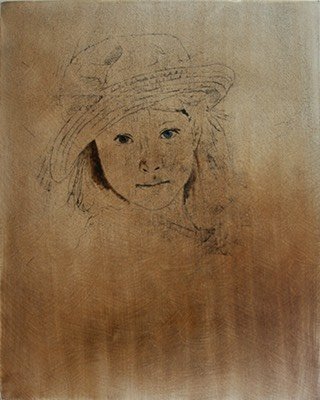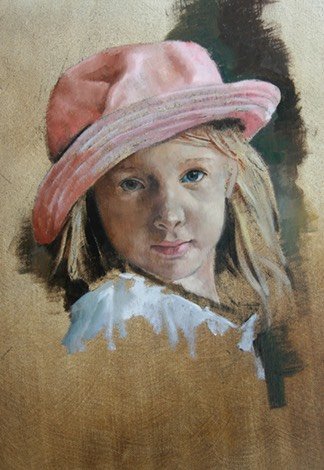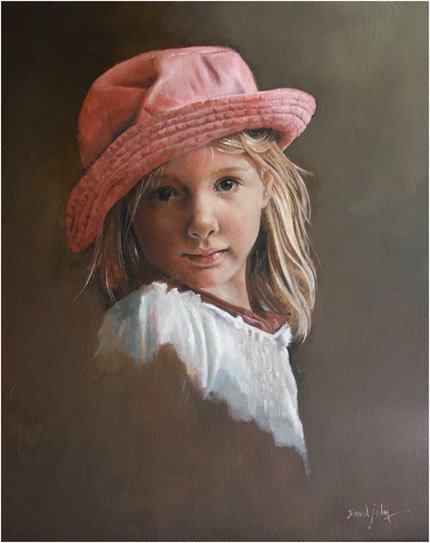The Head On Approach to Portraits
Portraiture can be a demanding skill for any artist and for a commissioned portrait this is especially so. Not only does the client want a painting they are happy to hang proudly on a wall but quite naturally the over-riding importance would be a likeness to the subject. My experience has shown me that if a basic near accurate drawing is there a likeness will be unavoidable.
My 5-year-old daughter Fin is not the easiest subject to paint but when she proudly showed me her pink hat how could I resist? I posed her in front of a tablecloth draped over my easel and asked her to keep still for at least a minute or two. No hope there but I managed a half dozen very quick drawings and a few shots with the camera before she began pulling faces and generally wanting to be anywhere else.
I had a 16” x 20” stretched canvas already prepared with 3 coats of gesso. A wash with turps and a thin mix of burnt umber, cobalt blue and a touch of cadmium yellow was applied and allowed to dry overnight. Using my drawings and photographs for reference I loosely sketched the outlines of her face with a soft BB pencil. Making sure that I had the pose I wanted. I arranged some paper, pencils and tape in my studio for Fin to play with so that she was always near and available. I check the drawing against her until I have at least a hint of a likeness. I double-checked the work by looking at it in a mirror. This is a valuable technique for seeing that nothing is skewed like one eye being higher than the other. I will often use the mirror throughout the process, as it is very easy to overlook mistakes. A fresh view in the mirror will make any mistake jump out at you.
When I’m happy with the drawing a squirt of fixative (actually it’s hair spray) to prevent the pencil lines mixing with my paint and I’m ready to begin.
My preferred brushes are flat and filbert sables and a couple of fine round sable brushes for detail.
Painting loosely with a flat number 4 brush I block in the darks such as the pupils, nostrils, and parts of the hair with burnt umber and Ultramarine using Liquin as a painting medium.
At this stage I introduce a little cadmium red for warmth and ultramarine to my palette. The shadow side is indicated with mixes of burnt umber, burnt sienna, yellow ochre and ultramarine. I now work from light to dark adjusting the tones on either side of the face.
With a mix of titanium white, burnt sienna and cobalt blue I roughly paint the eyes as they give me the darkest dark such as the pupils and the lightest light being the highlight of the eye and the tip of the nose, which I can use as a key to the rest of the work. Then I blocked in the cheek area that catches the light and introduce the mid-tones.
Another check in the mirror and I was satisfied with the structure of the face. I now concentrate on the hat with a mix of cadmium red, cobalt blue and titanium white with burnt umber for the darks. A dark tone for the background and a very light tone for the dress lifts the portrait from the canvas. At this stage I am concerned with contrasts.
Now the fun begins. The more I paint the more fluid the paint becomes. With a fine round sable brush I add detail to the eyes. The whites of the eyes are a mix of titanium white, cobalt blue, yellow ochre and cadmium red which gives a beautiful grey. The tone of this grey can be adjusted with more or less white. Using the same mix of colours from the face I block in the hair. I borrow Fin’s hat and prop it on a stand. The great thing about a hat is it will keep perfectly still if placed on a stand and I can finish painting it at my leisure.
I felt I needed more warmth in the cheek. A little cadmium red and yellow ochre did the trick. More work on the hat, background and shadow side of the face, making the shadows darker and then back to the lighter side.
It’s now important to work all over the canvas bringing the work together. I complete the background with a mix of burnt umber, ultramarine, cadmium yellow and titanium white finished with a light brushing with a sable fan brush. The eyes are detailed with a No 2 round sable brush. The mouth is made wider and the right eye slightly larger. A final look in the mirror to find the nose is a little too long. I position the highlight at the point of the nose slightly higher, which helps make the nose look broader. Finally I add a few bright highlights in the hat, hair and dress to give the portrait some zing.
What the artist used:
Stretched canvas (16” x 20”) with 3 liberal coats of gesso.
Oil and turps wash and left to dry overnight.
No. 8 Filbert brush.
No 2 and 4 round brush.
Sable Fan brush.
Oil paint:
Winsor & Newton Artist’s Oil Colour:
Titanium White, Burnt Umber, Burnt Sienna, Cobalt Blue, Cadmium Red, Yellow Ochre, Ultramarine, Cadmium Yellow.
Medium:
Winsor & Newton Liquin


David John
© All images and text on this site are copyrighted by the artist. Please do not replicate anything without the express permission of the artist.
Site by gcdesign
NAVIGATION
CONTACT
STUDIO
David’s Gallery is open to the public at 49 Manse Road, Arrowtown, Central Otago, New Zealand, 9302






